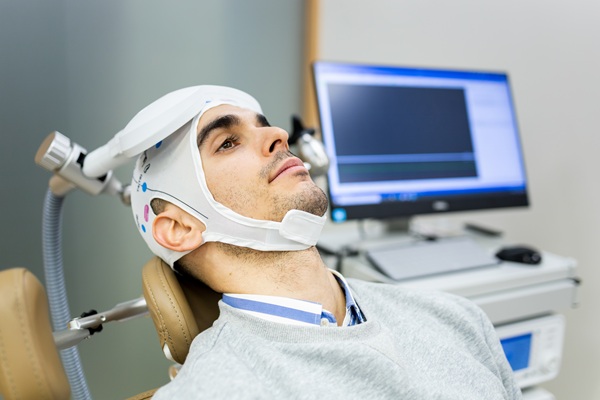A Brief Overview of Transcranial Magnetic Stimulation

Transcranial magnetic stimulation, also known as TMS, is a noninvasive procedure that uses magnetic fields to help stimulate nerve cells in the brain.
By delivering repetitive magnetic pulses to the brain, this treatment can help stimulate nerve cells in the region of the brain responsible for mood control. As a result, transcranial magnetic stimulation is often used to help alleviate or treat those with depression. It is also commonly used as a last resort when other treatments for depression have been ineffective.
An overview of transcranial magnetic stimulation
During a typical TMS session, an electromagnetic coil is placed against your scalp near the forehead. It stimulates the brain to assist in mood control. This process is completely painless and can help decrease activity in depression.
As mentioned earlier, this procedure is generally used after standard treatments for depression have proven to be ineffective.
TMS is often used in conjunction with medication or other forms of therapy like psychotherapy.
Risks and side effects
Transcranial magnetic stimulation does not require surgery or any electrodes. You do not need anesthesia or any medications during the procedure.
Although transcranial magnetic stimulation is considered a safe and well-tolerated form of treatment, it can come with some side effects. These side effects are generally mild to moderate and often occur over the first few individual sessions.
Some side effects of TMS include:
- Headaches
- Scalp discomfort
- Light tingling
- Spasms or twitching of facial muscles
- Lightheadedness
Side effects generally decrease and fade away once treatment has been adapted. Your specialist or doctor can easily adjust the level of stimulation if symptoms of pain continue to occur during the procedure.
Preparation
Before trying TMS, you may need a physical exam as well as a psychiatric evaluation help ensure that TMS is a safe and reasonable option in fighting depression. Treatment is often done within a doctor’s office or clinic.
Do not expect to see results in one session. Generally, sessions are carried out over the span of several weeks. You may need to visit the doctor anywhere between two times a week for up to six weeks.
Your first treatment
You may be nervous about TMS, but there is nothing to fear. You will first be taken into the treatment room where you will most likely be given earplugs to wear during the procedure.
An electromagnetic coil is then placed against your head and will begin to produce stimulating pulses. These pulses may last for a few seconds before disappearing. This process is called mapping. Your doctor will choose how much energy your brain needs.
Each treatment will last approximately 40 minutes.
Do you want to try TMS?
Although transcranial magnetic stimulation is still a relatively new technology, many patients are finding this therapy to be an excellent way to manage depression. If you are looking for a new for treatment to help cope with your depression, then ask your doctor if TMS can help you.
Request an appointment here: https://futurepsychsolutions.com or call Future Psych Solutions at (803) 335-5232 for an appointment in our Columbia office.
Check out what others are saying about our services on Yelp: Read our Yelp reviews.


